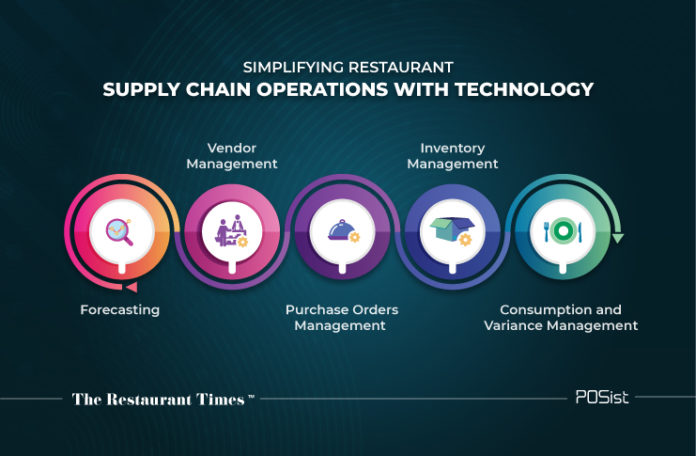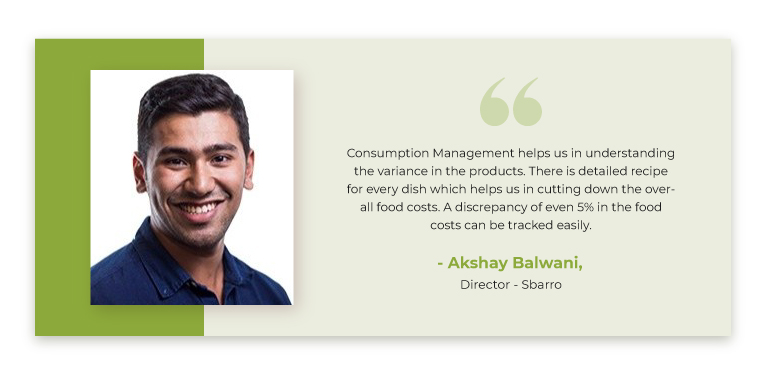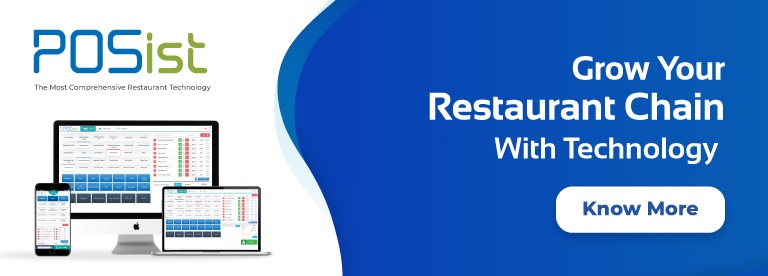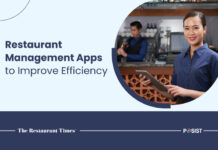The most successful restaurants have extremely efficient supply chain operations. They achieve this efficiency by using technology that is designed to solve operational and growth challenges for restaurants.
Despite major advancements in recent years in supply chain technology, most restaurateurs and their vendors / suppliers still are not connected with a unified view of supply and demand. When this supply – demand for a restaurant goes out of sync, it leads to losses at several levels. Wastage in the kitchen, un-confirmed supply of resources and finally broken customer service are the resultant of the sub-optimal restaurant supply chain.
The fastest growing restaurants have designed their supply chains in a way that they are able to address the following important factors :
- Manage inventory as per changing customer demands
- Make informed forecasts as per past data and new trends
- Remove ‘demand blind spots’ by using data from their integrated POS
Supply chain management is critical for the restaurant industry mainly because to run a successful restaurant; there are several moving parts across the kitchen, dining, order taking, billing and several backend processes that form the backbone of a thriving restaurant. The most successful restaurants have one common reason : their customers love the food and the overall experience. The backend that makes it all happen is the technology that enables the restaurateur to manage supply-demand efficiently.
In this article, we cover the following:
- A glossary of the Supply chain operations in the restaurant industry.
- What are the problems in handling operations in the restaurant industry?
- How to simplify supply chain operations with the use of technology?
As a restaurant grows, the supply chain becomes more complicated. This complexity has arisen the need for stronger visibility of the overall supply chain process.
Many restaurant owners are unable to figure out this complexity. This article hence captures the problems that restaurants face to maintain consistency across all levels of supply chain operations. We also discuss how does technology streamline the entire supply chain process for restaurants?
The 5 Essential Elements Of Supply Chain In The Restaurant Industry
- Demand sensing/ Forecasting: The supply chain cycle in the restaurant begins with a deep understanding of forecasting demand. This gives a holistic view to the restaurant to evolve their offers and menu as per customer demand.
- Vendor management: In the restaurant business finding the right vendors is necessary for maintaining quality and efficiency. Also, it is important to use technology that helps on-board and manage vendors as per quality and efficiency.
- Purchase order management: For restaurant chains with multiple outlets, based on different consumer habits, replenishment of orders also varies. One outlet may require a different raw material than the other, or there might be a difference in the quantities.
- Inventory management: A major cause of dissatisfaction in the consumers is when there is a crisis of ‘out of stock’. To avoid the mismanagement, restaurants maintain a sufficient quantity of all the items or raw materials required for food preparation. An efficient supply chain operation ensures minimal wastage / losses.
- Consumption and Variance Management: For a restaurant, it is essential to understand how much inventory is required for meal preparation and what is the actual consumption. The variance compares the physical stock (current counted inventory) with the ideal stock (volume of the stock that should be present). Consumption management is vital to understand if the restaurant staff is maintaining a set of standards for food preparation.
How Is Technology Solving The Supply Chain Complexities For The Restaurant Industry – Common Problems & Solutions
Handling supply chain operations in restaurants is a process which requires synchronization between the demand and the supply. Traceability and transparency are of utmost importance. Technology leads to better visibility in the entire supply chain, directing a broader understanding of the processes. It connects all the associated partners involved in the process on a single platform. Just a single click can provide all the necessary details of the entire order cycle.
Below we discuss the common problems in the supply chain processes and the solutions that technology provides:
Forecasting
Forecasting or demand sensing is a critical step in the entire cycle of restaurant supply chain operations.
To understand this, let’s take the example of a restaurant chain where Product X has observed the highest sales. However, Product Y has been the least selling item across the menu.
In spite of marketing efforts, product Y didn’t perform well in the market. Due to market conditions, the sale of Product X also reduced owing to a shortage of supply. As a result, the overall sales of the restaurant were hit.
This resulted in stock wastage that incurred higher losses which lead to cost-cutting across various operations, ultimately affecting relations with vendors.
Simplifying Forecasting With Technology – Automated Forecasting Via Restaurant POS
An automated forecasting module provides the projection of the future sales volume on the basis of consumption patterns of customers. Based on the in-hand physical stock in the kitchen and item-wise sale from each outlet, it is easy to estimate the inventory requirements. Demand sensing systems generate forecasts in both the menu and raw materials items. Restaurateurs can create offers on menu items specific to every outlet. A proportionate estimation of the inventories also removes the issues related to the ageing of the raw materials.
Vendor Management
Vendor management is critical for a restaurant operation of any scale and size. Whether you are a fine-dine, a QSR chain or an enterprise-grade operation, it is essential to integrate vendor-partners and track them via technology.
Poor vendor management can lead to:
- A shortage in the raw materials supplied by the vendors to a restaurant
- Deterioration in the quality of the ingredients due to poor storage conditions
- Failure in shipment or delay in timely delivery of orders
- High fixed costs due to economic conditions
The procurement of goods and services is managed by integral support and management between the vendors and the supply chain managers. A lack of proper vendor management results in poor deliverance of quality right from the kitchen.
Simplifying Vendor Management With Technology – Centralized Vendor Management Via Restaurant POS
A centralized panel for maintaining the records of all the vendors mitigates the risk involved with missing information. Tracking of important information like invoice details, contract details, order details, delivery details becomes easy. Restaurants can maintain a record of the inventory received from various vendors at a central level
It is possible to manage the price variation of different vendors from one panel. A proper vendor management system initiates a feedback loop between the purchasing department and the vendors.
Purchase Order Management
Say there is a restaurant chain with two outlets that is raising purchase order based on the average requirements. It is distributing the inventory equally to all the outlets. Soon after the delivery of an order, it is learnt that one outlet is running short of inventory, the second outlet has an excessive inventory with no storage facilities. The restaurant chain also faces the problem of missing out or receiving the wrong item.
Occurrence of this situation indicates that the inventory requirements of each outlet were not analysed.
Simplifying Purchase Order Management With Technology – Analyse Outlet Level Stock Requirement Via Restaurant POS
With technology in place, a restaurant can track and analyze the purchasing order needs concerning sales. Restaurateurs can view and analyse the stock requirements for every outlet. Based on the requirements of each outlet, purchase orders can be created and directly sent to the vendors. The restaurants avail detailed consumption information that helps them also to plan their shipment. All the order related details like order status, items purchased, receivables are monitored. Therefore, the restaurant can maintain a track of its inventory. Standard quality is maintained with equal distribution of inventory. All of it at predefined costs.
Inventory management
Manual interventions in inventory management are time-consuming and ineffective. It is challenging to manage the circulation of raw materials. Inventory is perishable, and no mechanism of FIFO results in wastage. Analysing the overall sales of all the outlets without an automated solution also results in an unequal distribution of stock. Mismanagement in the inventory results in cash flow problems.
Simplifying Inventory Management With Technology – Real Time Inventory Tracking Via Restaurant POS
An automated module enables real-time inventory tracking, which detects any discrepancy related to the usage or consumption of raw materials. Restaurateurs can understand the stock requirements of each outlet and ensure that consistency remains constant. An inventory management system also minimizes the wastage of the perishable inventory by calculating the shelf life of the items and also the number of days until which the stock will last. It curbs food costs by standardizing the recipe on a central level.
Consumption Management
To understand the importance of Consumption Management, let us assume a scenario of a restaurant chain.
The head chef of the restaurant chain has set a uniform standard for preparing the dish, which requires a specific consumption of raw materials. Before replenishment, the number comparison between the ideal stock with the actual physical stock doesn’t tally, indicating either wastage or pilferage.
Understanding the consumption levels of raw materials and inventory sets a record for the restaurateurs to monitor if the restaurant is following the standard guidelines.
Simplifying Consumption Management With Technology – Reducing Wastage & Pilferage Via Restaurant POS
Implementing technological solutions in consumption management helps the restaurant to identify the loopholes in the usage of inventory. When a restaurant enters the actual raw material consumption data that should be maintained by the staff, the system automatically displays the ideal consumption of stock. It indicates the product managers of the possibilities of excessive usage, wastage or pilferage. A detailed descriptive structure for recipes also cuts down the unnecessary usage of raw materials, thus cutting down the overall food costs.
How convenient would it be to track the entire order cycle of your restaurant on a single screen? With the help of technology, this is how some of the largest restaurant chains tackle the complexities of their supply chain.
Below is the list of critical questions that a restaurateur must consider to ensure that supply chain operations scale with business growth:
- As a restaurant, do we have the strategy in place to ensure that our supply chain grows along with our scale-up plans?
- Are we using technology to set scalable and dependable processes, or are we dependent on luck and human effort that has a much higher chance of error?
- Have we learnt from peers and successful restaurateurs in our space on how they have structured supply chain operations with technology to match their scale?
The future is clear for growing restaurants. It is the technology backend that will define how efficiently does the restaurant run its backend and how it delivers an incredible experience for customers.
To know more about how the restaurant POS can help you manage supply-demand efficiently, talk to our experts today.























